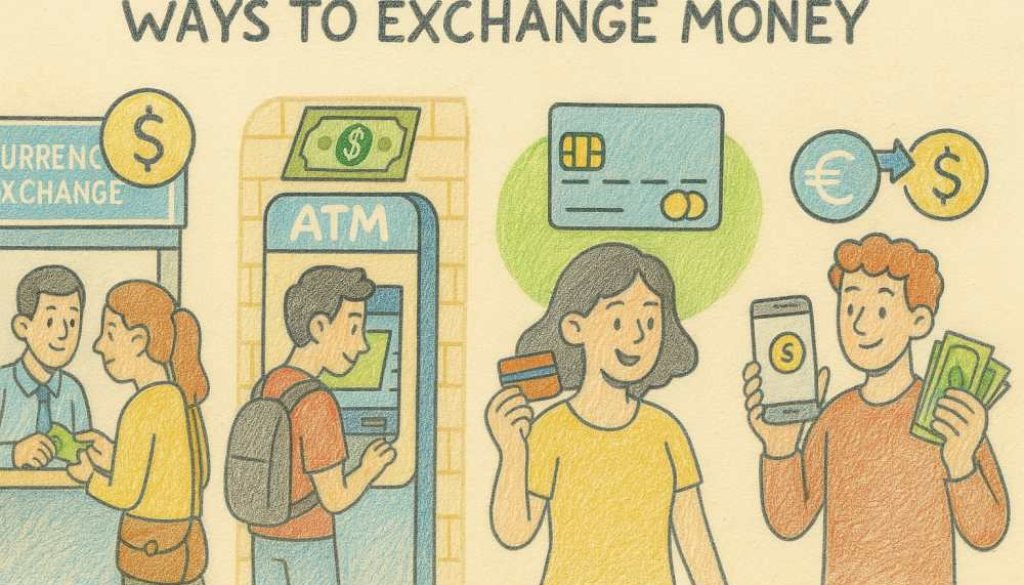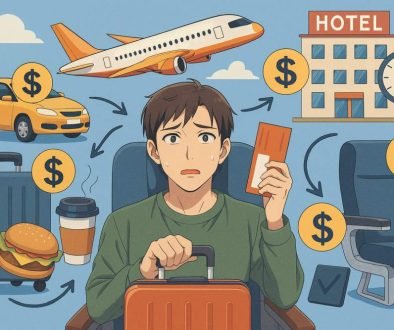The Ultimate Guide to Exchanging Money While Traveling
So, your bags are packed, your passport is ready, and you’re just about to board that flight. But then it hits you — should you exchange money now? At the airport? Wait until you land? Use your card? Withdraw from an ATM?
When it comes to travel, managing money smartly can save you hundreds of dollars — or cost you more than a nice hotel night if you’re careless. That’s why we’ve created this colorful and practical guide to all your currency exchange options, so you don’t end up paying more than you bargained for.
Let’s break it down 👇
🏦 The 5 Main Ways to Exchange Money (And When to Use Each)
1. Currency Exchange Booths (The Airport Trap?)
-
✅ Good for: Emergencies or small amounts
-
❌ Downsides: Often the worst exchange rate, with hidden fees baked into the rate
-
✨ Pro Tip: If you must use one, compare booths and ask exactly how much you’ll get after fees.
2. ATMs Abroad (Usually the Best Rate)
-
✅ Good for: Withdrawing local currency at a solid interbank rate
-
❌ Downsides: Your bank might charge a foreign withdrawal fee + ATM fee
-
✨ Pro Tip: Use a travel-friendly bank card like Wise, Revolut, or Charles Schwab to minimize fees.
3. Credit Cards (Simple, Smart – but Watch Out)
-
✅ Good for: Hotels, restaurants, shopping, car rentals
-
❌ Downsides: Some cards charge foreign transaction fees (up to 3%)
-
✨ Pro Tip: Choose a credit card with no foreign transaction fees, and always pay in local currency to avoid dynamic currency conversion scams.
4. Cash from Home (Familiar, but Risky)
-
✅ Good for: Peace of mind and budgeting
-
❌ Downsides: Bad exchange rate from your local bank, risk of loss or theft
-
✨ Pro Tip: Exchange a small amount before you leave, just to cover first-day expenses.
5. Currency Exchange Apps (Yes, That’s a Thing Now)
-
✅ Good for: Transferring between your own accounts, or sending money
-
❌ Downsides: May not help with physical cash
-
✨ Pro Tip: Use apps like Wise or Revolut for virtual cards, fast transfers, and smart conversions.
🧮 How Much Money Should You Exchange?
💡 Short answer: Don’t overdo it.
Some travelers exchange large amounts to avoid fees. But what if you don’t spend it all? You’ll lose again when converting leftover currency back — especially if it’s a less-used currency like Thai Baht or Moroccan Dirham.
✔️ Better idea: Withdraw or spend in smaller chunks. And unless it’s a country where cards don’t work, don’t carry your whole travel budget in cash.
🔄 Should You Convert Leftover Money Back?
Depends.
-
🟢 Small amount? Keep it as a souvenir or for your next trip.
-
🔵 Larger amount? Consider converting only major currencies (like EUR/USD/GBP) back at your home bank — not at the airport.
-
❌ Avoid reconverting niche currencies like Indonesian Rupiah or Colombian Peso — you’ll lose too much in the process.
❓ Common Questions
Q: Is it cheaper to withdraw money abroad or exchange at home?
A: Usually cheaper to withdraw abroad using a no-fee debit card.
Q: Can I use USD or EUR in other countries?
A: Sometimes — but it often leads to bad rates or refusal. Local currency is king.
Q: How can I avoid hidden fees when spending abroad?
A: Always pay in the local currency and use cards with zero foreign transaction fees.
🧠 Final Travel Tip:
Think of currency like sunscreen:
It’s annoying to plan for, but if you ignore it, you’ll get burned.




November 24, 2025 @ 9:03 am
Thanks for sharing. I read many of your blog posts, cool, your blog is very good. https://accounts.binance.info/ph/register-person?ref=IU36GZC4
November 24, 2025 @ 11:36 pm
I don’t think the title of your article matches the content lol. Just kidding, mainly because I had some doubts after reading the article. https://www.binance.info/register?ref=IHJUI7TF
December 2, 2025 @ 3:23 pm
Okay, W500, might as well check it out. Someone told me they had a good bonus going on. I’ll update if I try it, but if bonuses are your style w500.
December 4, 2025 @ 9:11 am
Your point of view caught my eye and was very interesting. Thanks. I have a question for you. https://www.binance.com/en-NG/register?ref=YY80CKRN
December 9, 2025 @ 12:15 am
Trying to land some big wins at xx88win! Website looks clean, and the signup process was a breeze. Let’s see if I can break the bank! xx88win
December 12, 2025 @ 6:26 pm
Can you be more specific about the content of your article? After reading it, I still have some doubts. Hope you can help me.
December 18, 2025 @ 3:32 pm
Your point of view caught my eye and was very interesting. Thanks. I have a question for you. https://www.binance.info/zh-CN/register?ref=WFZUU6SI
December 25, 2025 @ 12:52 am
Hey, just signed up on s666welcome and the vibe is pretty good! Easy to navigate and the games are decent. Definitely worth checking out! s666welcome
December 29, 2025 @ 5:10 pm
777kingcom is the real deal! I’ve been playing here for a while, and I’ve actually won some money! The site is reliable, and the customer service is pretty good too. Give 777kingcom a shot!
December 29, 2025 @ 10:59 pm
Hi, y’all. I tried using phtaya41. It’s the ideal solution if you don’t waste any time during login! Very intuitive and fast.
January 2, 2026 @ 11:21 pm
Your point of view caught my eye and was very interesting. Thanks. I have a question for you.
January 5, 2026 @ 6:54 am
Saw 23winslot mentioned in a forum. Gotta say, I’m impressed with the selection of slots. Found a few I’d never seen before. Seems promising so far. Worth a poke around, for sure. Click here: 23winslot
January 5, 2026 @ 9:03 pm
Kho game đa dạng và hấp dẫn là một trong những điểm mạnh của nhà cái tải app 888slot . Với sự đa dạng của các thể loại game bao gồm cá cược thể thao, Slot, lô đề, game bài,…, bạn sẽ không bao giờ cảm thấy nhàm chán hay tẻ nhạt khi tham gia trải nghiệm. TONY01-06S